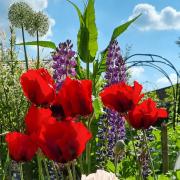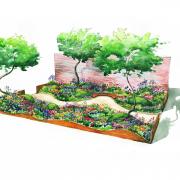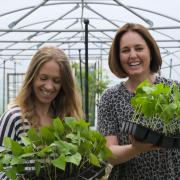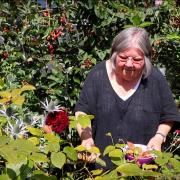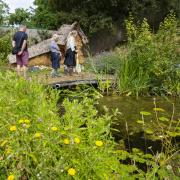January... we may still be held by the frozen grip of winter, but Mother Nature offers a signal that the warming embrace of spring draws closer every day.
Days begin to uncurl and stretch out once again, rewarding us with more daylight. Planted bulbs that have spent months nestled in the ground begin to push their delicate heads through the frozen soil putting on a captivating display. For veg growers, aubergine, pepper and chilli seeds are quickly sown and placed on heated mats to germinate, promising rich summer harvests.
So, embrace the year and get outside with some gardening jobs that will keep you warm and get your green spaces spring-ready.

Jobs for January
Don’t be too quick to bin your exhausted Christmas tree as there’s still plenty of value in it. Shred it for chippings to spread on ericaceous plants, such as blueberries, or on allotment paths. The branches can also make useful plant supports for growing peas and broad beans instead of bamboo canes. Of course, roughly breaking it up and leaving it in an unkept part of the garden makes a great home and shelter for garden wildlife.
Before Jack Frost runs wild in your garden and causes mayhem, beat him to the punch and install a few protective measures. Frozen water expands, which can force outside taps and pipes to burst, so insulate them from the cold and turn off the external water supply. Garden hosepipes should be collected and stored in a frost-free area like a shed or garage.
It’s important to brush fallen snow from greenhouses, cloches and cold frames. The extra weight can break the glass, plus the plants inside need all the warmth and light they can get. Remove snow from delicate evergreens and tree branches to prevent damage.

Although landscapes might be shy of colour this month, it’s an ideal time to carry out repairs or make garden improvements on structures, fences and paths. Winter gives us a true blueprint of our gardens, revealing areas that may normally be hidden by blooms and foliage. Furthermore, most plants will have retreated below the soil line, meaning they’ll be safe from a weighty boot or a heavy tool. However, If you can, keep off the grass. The freezing weather combined with your weight can cause permanent damage to a precious lawn.
A heat supply in your greenhouse will give you the advantage of making early sowings, for plants such as sweet pea and aquilegia. If you’ve been growing sweet peas since last autumn, then pinch out the tips as this will encourage side-shoots and result in a bushier plant.
Continue to harvest veg, such as winter brassicas, leeks, parsnips, carrots and swede. Once beds are freed up, aerate the soil by turning it over, then apply a thick layer of well-rotted manure, or compost. Getting this done before the month is out will give the organic matter time to release its valuable nutrients into the soil, making beds spring-ready.
Early starters

As we head into January, egg cartons cradling chitting potato tubers will begin appearing on gardeners’ windowsills. Chitting is purely speeding up the aging process of a tuber, and letting its eyes sprout. By the time you come to planting, ground temperatures still won’t be at their warmest, but those weeks of chitting will give your tubers a valuable head start.
To chit potatoes, stand the tubers apart (egg boxes make ideal holders), with their eyes facing upwards. Place somewhere warm, dry and with plenty of sunshine, such as a kitchen windowsill, porch or warm greenhouse. Try to keep sprouts down to three maybe four, so the energy isn’t too dispersed, thus producing weaker shoots. Six weeks on, your tubers should be ready for planting out.
Chillies and peppers need a long growing season, so January is not too early to sow your favourite varieties. However, these plants will need warmth, light and the protection of the indoors to safely get them through to spring. So, if your chitting potatoes are taking up all the warm spots, heat mats and plant lights maybe required. Seeds can be grown in modules, pots or trays to the depth of 6mm, and placed on a windowsill. Although germination can be slow, once their true leaves have been revealed, it’s important to pot them on. Keep them warm, well-lit and the soil moist.
For an earlier crop of rhubarb, trying forcing the plant. As soon as new growth appears from the crown, simply cover the plant over with a rhubarb forcer or container, excluding all light. By doing this, you’re simply speeding up its growth for an earlier harvest, and sweeter stems. Eight weeks on, the stalks should be 20-30cm long, and ready to harvest.

Don't forget...
Garden wildlife will appreciate a helping hand at this time of year. If you have bird-feeding stations, ensure food supplies are topped up, and water supplies are changed regularly and not left to freeze. If you have a fish pond, avoid smashing the ice if it freezes over, as this can shock, or even kill the fish. Instead, try to melt the ice gently with warm water.
If the cold weather starts to get the better of you, retreat indoors to a warming fire, a tasty homemade soup from your harvests, or finish off the last of the mince pies. Take a moment to think what you hope to achieve this growing season. Maybe this is the year you finally sign up for an allotment, join a gardening committee or enter a veg growing competition. Draw up plans, create seed lists and scramble through plant catalogues for ideas and inspiration. 2024 can be as small or as large as you want to make it, but it all starts from sowing that first seed.
About Ade
Ade Sellars is the Good Life Gardener, an award-winning writer, presenter and content producer with a passion for growing his own food in his kitchen garden. As well as running his own gardening business, Ade writes for magazines, produces tailored video content for gardening brands, flower shows and outdoor events, and regularly gives talks and demonstrations around the country. More at adesellars.com; youtube.com/@TheGoodLifeGardener; Instagram: adesellars












